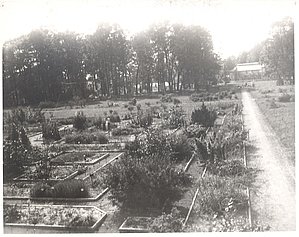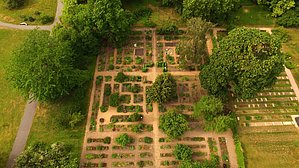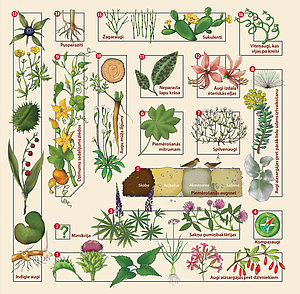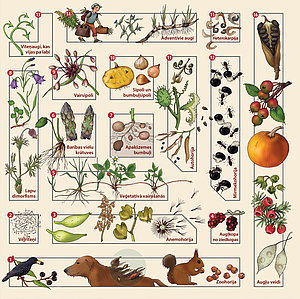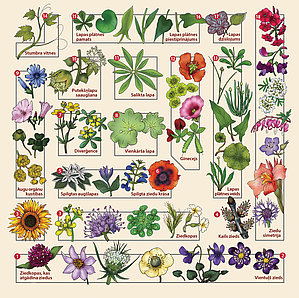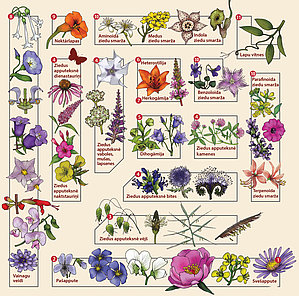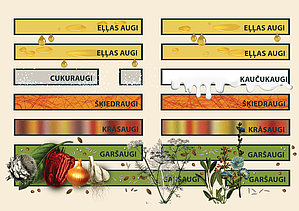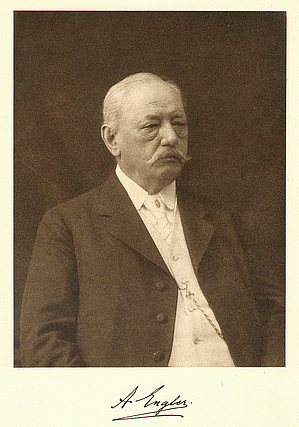Plant beds is the oldest exposition in the Botanical Garden, created in the 20's of the 20th century by the founders of the Garden: prof. Nikolajs Malta, prof. Pauls Galenieks, assoc. prof. Aleksandrs Zāmelis and gardener Mārtiņš Pālens, for a botany teaching purpose, and it illustrates a remarkable diversity of plant kingdom. The exposition consists of 4 parts: Biological and morphological beds, Technical plants, Medical plants and Order beds.
Except the Order beds, up to these days the arrangement has not been changed – the expositions keep a consistent botanical structure and plant beds, the same coarse sand paths and borders. Exposition has been preserved despite the fact that the teaching methods have been changed. It serves as a memorial to founders of the Garden and the garden culture of that time.
The exposition demonstrates the morphology and adaptations of plants. The territory of 2000 m2 is divided into 4 sections (A, B, C, and D). Plants with characteristic features are grown according to this layout to demonstrate morphology on the spot. Since 1957, there are 64 thematic beds including 171 subthemes.
The section for Plant adaptation (A) demonstrates specific exterior features of plants that have been formed as a result of different external conditions. One can study the way plants have adapted to protect themselves against animal attacks, to survive excessive drought or humidity, too strong sun radiation, etc. The section for Plant propagation and spreading (B) exhibits a variety of seeds, fruits, examples of vegetative propagation, and adaptions for seed dispersal by wind, animals and human. The section for Leaves and flowers (C) displays morphology of leaves (lamina, leaf margin, shape, venation, divergence, movements) and the wide diversity of flowers and their morphology (structure, raceme, colour, symmetry). Plants in the section for Pollination (D) demonstrate the dichogamy, heterostyly, the difference between cross-pollination and self-pollination, adaption to wind or insect pollination, etc.
There are more than 500 different taxa in this exposition, including woody plants, herbaceous perennials, annual and biennial plants.
The exposition demonstrates human uses of plants. Here are exposed different plants that are cultivated for oil (common sunflower Helianthus annuus L.), fiber (flax Linum usitatissimum L.), pigment (lady's bedstraw Galium verum L.), sweetener (manna ash Fraxinus ornus L.) and spice (caraway Carum carvi L.) producing.
The medicinal plant collection at the Botanical Garden of the University of Latvia is represented by 280 plant species. About 140 species of them grow wild in Latvian nature. These plants are used both in ethnobotany and medicine. Information about plant usage and collecting is given on plant labels (Latvian only).
Different physiological components are found in medical plant drugs, and as they have effect on human body or pathogens they can be used during treatment or prophylactic. These components are not concentrated equally in the whole plant, so only particular parts of the plant with highest value must be collected for drugs.
Plant systematic is studying plants occurring on the planet, placing them in order, describing and explaining their development and evolutionary relationship. There is more than one plant classification system.
In the time period from 1887 to 1909, two German botanists – Adolf Engler and Carl Prantl – developed a new plant classification system. In the so called Engler’s system, for the first time in the botany history, simple and more developed plants were placed together in one order starting with algae and ending with flowering plants. Die Natürlichen Pflanzenfamilien was used as a standard for flowering plant family classification in herbariums, floral papers and in order beds in botanical gardens up to 70ties of the 20th century.
In the Engler’s system, the plant families are grouped according to their origin, morphological similarities (particularly in the flower composition) and evolutionary development. As a result, the system starts with evolutionary oldest and morphologically simplest plant families like Liliaceae and ends with most recent and complicated families like Asteraceae.
Order beds were established in 1926 at the Botanical Garden of the University of Latvia and are represented by more than 100 plant families.

 CONFERENCE
CONFERENCE